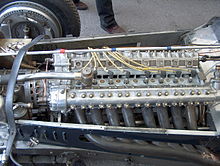Delage
Delage is a French luxury automobile and racecar company founded in 1905 by Louis Delâge in Levallois-Perret near Paris; it was acquired by Delahaye in 1935 and ceased operation in 1953.
[2] Like other early carmakers, Delage participated in motor racing, entering the Coupe de Voiturettes held at Rambouillet in November 1906 with a 9 hp (6.7 kW; 9.1 PS) racer.
[2] Seven days of regularity trials decided the entrants, and one of the two 9 metric horsepower (6.6 kW) Delage specials[3] was wrecked in the rain on the fifth; nevertheless, Ménard, the other works driver, came second in the event, behind a Sizaire-Naudin.
That year, racing success returned: Delage won the Grand Prix des Voiturettes held 6 July.
[2] Delage fielded three cars: a pair with 1,242 cc (75.8 cu in) (78 by 130 mm (3.1 by 5.1 in)) De Dion-Bouton twins, driven by Thomas and Lucas-Bonnard, and a radical 28 hp (21 kW) 1,257 cc (76.7 cu in) (100 by 160 mm (3.9 by 6.3 in)) one-cylinder[4] (built by Nemorin Causan) in the hands of Delage dealer Albert Guyot.
All three Delages finished this time, Thomas the quickest of the two-cylinder cars, while the team also took home the regularity prize.
[5] Delage converted to four-cylinder engines in 1909, at first provided by De Dion and Edouard Ballot; shortly, the company were producing their own sidevalve fours, too.
[7] The CO became the CO2, which changed to an overhead valve twin-plug head, producing 88 hp (66 kW; 89 PS), while the DO was supplanted by the DE with a 2,117 cc (129.2 cu in) (72 by 130 mm (2.8 by 5.1 in)) sidevalve four and, unusual in a production car even in this era, four-wheel brakes.
The next year, the new 14 hp (10 kW; 14 PS) DI also switched to OHV with a 2,121 cc (129.4 cu in) (75 by 120 mm (3.0 by 4.7 in)) four, fitted with magneto ignition and thermosyphon cooling; all had four-speed gearboxes and Zenith carburettors.
[7] At the other end of the scale, the GL (Grand Luxe), also known as the 40/50, replaced the CO2, being fitted with a magneto-fired 5,344 cc (326.1 cu in) (90 by 140 mm (3.5 by 5.5 in)) overhead cam six.
[7] In 1923, a hillclimb car with DI chassis, larger wheels and tires, and 5,107 cc (311.6 cu in) (85 by 150 mm (3.3 by 5.9 in)) CO block (with three Zenith carburetors) was produced.
This car was joined by a 10,688 cc (652.2 cu in) (90 by 140 mm (3.5 by 5.5 in)) V12, which broke the course record at the Gaillon hillclimb, with Thomas at the wheel.
[8] A 1925 car had a 5,954 cc (363.3 cu in) (95 by 140 mm (3.7 by 5.5 in)) six, again using the GL block, with four valves per cylinder and twin overhead cams.
[5] In 1913, the new type Y set the fastest lap time at the French Grand Prix at Le Mans, and in 1914, this same car won the 1914 Indianapolis 500 with René Thomas at the wheel.
to the French Grand Prix with 4½-liter twin-cam desmodromic valved racers featuring twin carburettors, five-speed gearbox, and four-wheel brakes.
[5] In 1914, Delage emphasized its focus on competition by creating the type O Lyon Grand Prix, while at the same time moving towards the luxury car market with 6 cylinders of a large class.
[citation needed] A Delage 155 B won the first Grand Prix of Great-Britain in 1926, driven by Louis Wagner and Robert Senechal.
Delage's Grand Prix effort saw a Plancton-designed 1,984 cc (121.1 cu in) (51.3 by 80 mm (2.02 by 3.15 in)) four overhead cam V12.
[12] The 110 hp (82 kW; 110 PS) car, driven by Thomas, fell out of the French Grand Prix in 1923, but went on to perform well for the bulk of the 1923 and 1924 season.
[9] With supercharger added in 1925, bringing output to 195 hp (145 kW; 198 PS), it won at Montlhéry and Lasarte,[9] proving as fast as the Alfa Romeo P2, but rarely racing it directly.
[9] This car was supplanted in 1926 by a Lory-designed supercharged 1.5-liter twincam straight eight of 170 hp (125 kW); capable of 130 mph (210 km/h), it was the company's last Grand Prix entrant.
[9] But the backlash of the economic crisis of 1929 arrived and manufacturers of luxury cars all over the world suffered from poor sales.
[9] Financial pressures never disappeared, however, and during the spring of 1932 Louis Delage was obliged to take out a 25 Million franc loan in order to finance the tooling needed to put the D6 into production.
Watney had taken control as president of SAFAD, but he was a British national and in June 1940 he was obliged to leave Paris as the German Army arrived.
[15] Watney stayed in France, at his villa in Beaulieu, until the end of 1942 after the Germans had completed their occupation, but already in December 1940 the presidency of the SAFAD business had passed directly into the control of Delahaye.
[17] A longer wheelbase 1952 special version, bodied by Guilloré, was owned by National Assembly president Édouard Herriot.
[18] Louis Delâge himself, who had lived in poverty and quasi-monastic isolation since bankruptcy in 1935 had enforced the transfer of his company to Delahaye,[9] died in December 1947, and during the next few years any residual autonomy that the business had enjoyed disappeared.








